As businesses continue to adopt remote work and digital collaboration, cloud-based project management software has become an essential tool for effective team coordination and workflow management. Cloud-based project management software offers a centralized platform for tracking project progress, assigning tasks and sharing documents. This makes it easier for teams to stay organized and aligned.
With the increasing demand for cloud-based solutions, several project management software options have emerged, each with its unique features and benefits. In this article, we’ll discuss the best cloud-based project management software of 2023 and help you determine which one is the best fit for your business.
Jump to:
Best cloud project management software comparison
To help you decide which project management software best suits your needs, we have compiled a comparison table featuring key aspects of each product. The table highlights important features, such as collaboration tools, integrations, pricing and more, allowing you to evaluate and compare your options quickly.
Below, we have reviewed six top cloud-based project management software options and highlighted their best use cases, key features, pros, cons and pricing.
| Free plan | Time tracking | Gantt charts | AI | Pricing | |
|---|---|---|---|---|---|
| monday.com | Yes | Yes | Yes | Yes | $8 user/month |
| Smartsheet | Yes | Yes | Yes | Beta | $7 user/month |
| Zoho Projects | Yes | Yes | Yes | AI chat | $5 user/month |
| Jira | Yes | Yes | Yes | NLP AI | $8.15 user/month |
| Confluence | Yes | No | No | Limited | $6.05 user/month |
| Asana | Yes | Limited | Yes | Yes | $10.99 user/month |
| Notion | Yes | No | No | Yes | $8 user/month |
| Hive | Yes | Limited | Yes | Yes | $5 user/month |
monday work management: Best for ease of use
Figure A
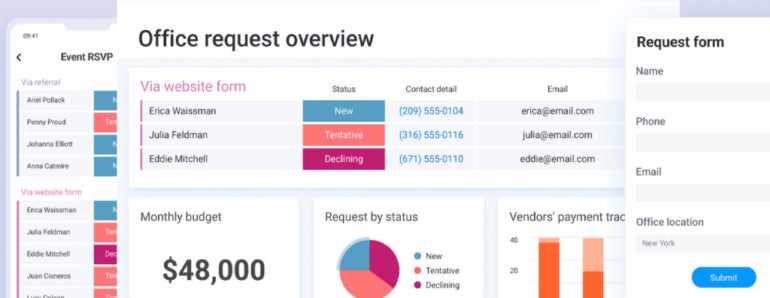

monday work management is a visually appealing and user-friendly cloud-based project management software option that helps teams collaborate, manage tasks and track project progress. The platform offers a variety of project views, including boards, timelines and calendars. monday work management also provides a wide range of prebuilt templates, integrations with popular tools and automation features to streamline project workflows.
Pricing
- Individual: Free forever for up to two seats.
- Basic: $8 per seat per month, billed annually, or $10 per seat billed monthly.
- Standard: $10 per seat per month, billed annually, or $12 per seat billed monthly.
- Pro: $16 per seat per month, billed annually, or $20 per seat billed monthly.
- Enterprise: Contact sales for a custom quote.
Features
- Visual task management: Intuitive boards and customizable views make it easy to manage tasks and monitor progress.
- Automations: With monday work management, users can streamline processes with custom automation workflows.
- Integrations: The software offers seamless integration with popular tools such as Slack, Google Drive and Microsoft Office.
Pros
- Easy-to-use interface.
- Highly customizable.
- Strong collaboration features.
Cons
- Can be overwhelming for new users.
- Limited free version.
Why we chose monday.com
monday work management is one of the most popular project management tools for a reason. They have an engaging, fast design and offer both simple and advanced capabilities for all teams. Your team can be new and small or big and established, the software has an abundance of features to fit your needs. The variety can be a lot for less experienced software users, but most can adapt relatively quickly.
For more information, check out our full monday Work OS review.
Smartsheet: Best for spreadsheet-based project management
Figure B
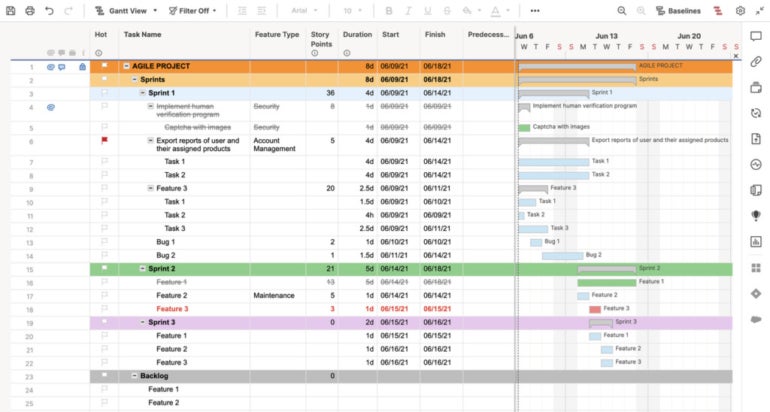

Smartsheet is versatile project management software that combines the conventionality of spreadsheets with the capabilities of project management tools. With its intuitive interface and powerful features, such as task management, resource allocation and reporting, Smartsheet enables teams to plan, track and execute projects efficiently. The software also offers advanced automation and integration capabilities, making it suitable for businesses of all sizes.
Pricing
- Free: $0 for one user and up to two editors.
- Pro: $7 per user per month, billed annually, or $9 per user billed monthly.
- Business: $25 per user per month, billed annually, or $32 per user billed monthly.
- Enterprise: Contact Smartsheet for a custom quote.
Features
- Grid view: Smartsheet delivers a familiar spreadsheet-style interface for easy task management.
- Automated workflows: Users can set up rules to automate repetitive tasks and processes.
- Flexible templates: Its flexible templates provide users with a wide range of selections to suit various project types.
Pros
- Familiar interface for spreadsheet users.
- Robust reporting capabilities.
- Wide range of templates.
Cons
- A steep learning curve for advanced features.
- Limited integration options in the basic plan.
Why we chose Smartsheet
One of the best project management tools for managing content, reports and data is Smartsheet. They offer an array of helpful business templates for all sorts of use cases to meet your unique project and data needs.
For more information, check out our full Smartsheet review.
Zoho Projects: Best for budget-conscious businesses
Figure C
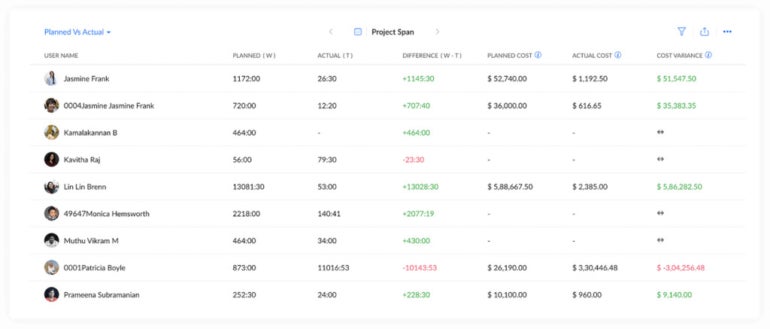

Zoho Projects is a cloud-based project management software solution designed to help teams plan, collaborate and deliver projects on time. It offers robust task management, time tracking and document management features. With its customizable interface, built-in Gantt charts and extensive reporting capabilities, Zoho Projects caters to the needs of various industries and project sizes. The software also seamlessly integrates with other Zoho products and popular third-party tools.
Pricing
- Free: $0 for up to three users.
- Premium: $4 per user per month, billed annually, or $5 per user billed monthly.
- Enterprise: $9 per user per month, billed annually, or $10 per user billed monthly.
Its Premium and Enterprise plans have a 10-day free trial.
Features
- Time tracking: Teams can monitor and manage time spent on tasks and projects.
- Issue tracking: Zoho Projects makes it easy to track and resolve bugs and issues.
- Customizable dashboards: Users can personalize dashboards to show relevant project information.
Pros
- Affordable pricing.
- Strong feature set for the price.
- Good integration with other Zoho products.
Cons
- Limited storage in the basic plan.
- Less intuitive interface compared to competitors.
Why we chose Zoho Projects
Zoho Projects offers teams advanced project management tools for fairly low costs. On top of strong reporting and analytics, you can integrate with other business software by Zoho. You can integrate with Zoho Books, Zoho Meeting and Zoho CRM for increased functionality.
For more information, check out our full Zoho Projects review.
Jira: Best for software development teams
Figure D
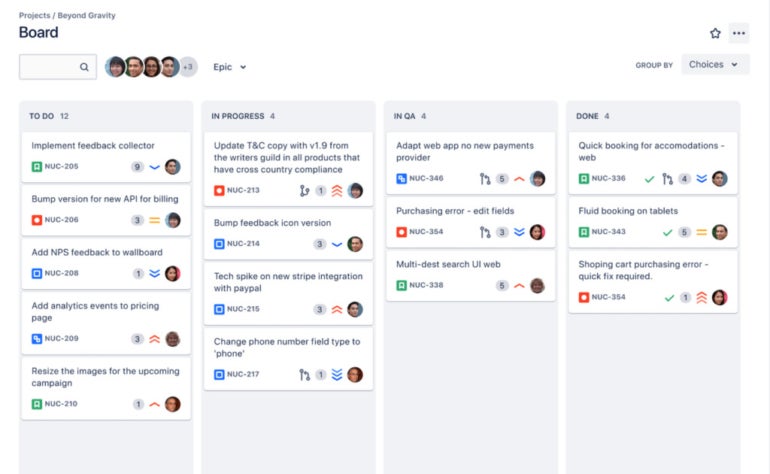

Jira Service Management is a popular project management tool specifically designed for software development teams. It provides comprehensive issue tracking, customizable workflows and integration with popular developer tools like Bitbucket and GitHub. Jira Service Management’s powerful features and robust reporting capabilities make it an ideal choice for managing complex software projects and ensuring timely delivery.
Pricing
Pricing for Jira Service Management is on a sliding scale and lowers as more users are added. Based on a 10-user plan, Jira Service Management has the following costs:
- Free: $0 for 10 users for the monthly subscription only.
- Standard: $8.15 per user billed monthly or $850 per year.
- Premium: $16 per user billed monthly or $1,600 per year.
- Enterprise: Only billed annually. Available for teams with more than 800 users. Contact Jira Service Management sales for a custom quote.
Features
- Scrum and kanban boards: Manage and track the progress of software development projects using Agile methodologies, Jira Service Management’s Scrum and kanban boards.
- Customizable workflows: Users can define and modify workflows based on their team’s processes.
- Integration with developer tools: Seamlessly integrate with popular developer tools like Bitbucket and GitHub.
Pros
- Powerful issue-tracking and management features.
- Highly customizable.
- Robust reporting and analytics.
Cons
- Steeper learning curve compared to other tools.
- May not be suitable for non-software development projects.
Why we chose Jira Service Management
Jira Service Management is a solution with advanced features for tech-savvy teams. Atlassian has other classic project management like Confluence and Trello, whereas Jira Service Management is more niche for complex development projects. Even with the learning curve, it’s worthwhile for your project insights via analytics and reporting.
For more information, check out our full Jira Service Management review.
Confluence: Best for team collaboration and documentation
Figure E
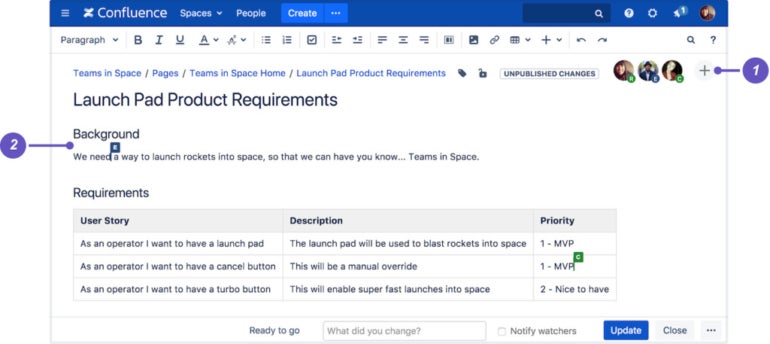

Confluence is a cloud-based collaboration and documentation tool from Atlassian that works seamlessly with Jira Service Management. It allows teams to create, edit and share documents in real-time, making it an excellent choice for building a centralized knowledge base. Confluence’s collaborative editing and integration with Jira Service Management make it an ideal companion for software development teams and businesses looking to improve their documentation and collaboration processes.
Pricing
Confluence’s pricing is on a sliding scale and lowers as more users are added to the plan. Here are Confluence’s rates based on a 10-user team:
- Free: $0 for ten users for the monthly subscription only.
- Standard: $6.05 per user billed monthly or $600 per year for up to 10 users.
- Premium: $11.55 per user billed monthly or $1,150 per year for up to 10 users.
- Enterprise: Only billed annually. Available for teams with more than 800 users. Contact Confluence for a custom quote.
Features
- Collaborative editing: Confluence enables users to work together on documents in real-time.
- Knowledge base: Teams can create a centralized repository for company knowledge.
- Integration with Jira Service Management: Easily link Confluence pages to Jira Service Management issues.
Pros
- Excellent for creating, organizing and sharing documents.
- Real-time collaborative editing.
- Integration with other Atlassian products.
Cons
- Lacks task management features.
- Not ideal as a standalone project management tool.
Why we chose Confluence
One of the best project management tools for complex projects is Confluence. It’s great for document management and staying on top of detailed research. Some may experience a slight learning curve, but the software interface avoids overwhelming new users. You don’t have to be a software developer to be able to use or benefit from the application.
For more information, check out our full Confluence review.
Asana: Best for balanced project management
Figure F
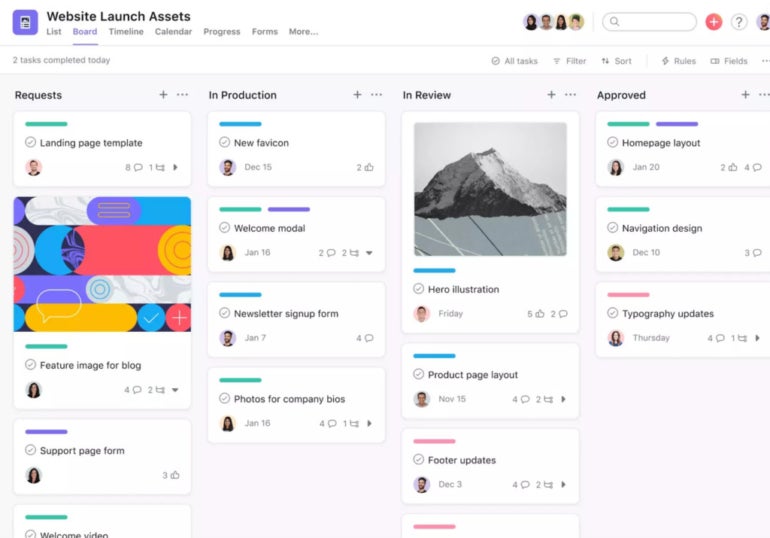

Asana is a flexible and user-friendly cloud-based project management solution that helps teams manage tasks, projects and workflows efficiently. Its standout features include multiple project views, prebuilt templates and custom automation rules. Asana’s intuitive interface and wide range of features make it suitable for teams of all sizes and industries. Additionally, the software integrates with popular third-party tools, enhancing its overall functionality.
Pricing
- Basic: $0 for unlimited tasks, projects, messages, activity logs and storage.
- Premium: $10.99 per user per month, billed annually, or $13.49 per user billed monthly.
- Business: $24.99 per user per month, billed annually, or $30.49 per user billed monthly.
- Enterprise: Contact Asana for a custom quote.
Features
- Flexible project views: Users can choose from list, board, timeline or calendar views for their projects.
- Templates: Teams can start projects quickly with prebuilt templates for various industries and use cases.
- Automation: Asana offers custom rules to help teams automate routine tasks.
Pros
- Intuitive and easy-to-use interface.
- Wide range of features for task and project management.
- Integrations with popular third-party tools.
Cons
- Limited free plan features.
- Advanced features may require higher-tier plans.
Why we chose Asana
Asana is a pretty universal choice that’s hard not to include. It offers advanced features with a simple interface. Teams with both small and complex projects can benefit equally. If you want a solution tailored to your industry use case, you may want to keep shopping around, but Asana is good for handling most projects.
For more information, check out our full Asana review.
Notion: Best for collaboration on a budget
Figure G
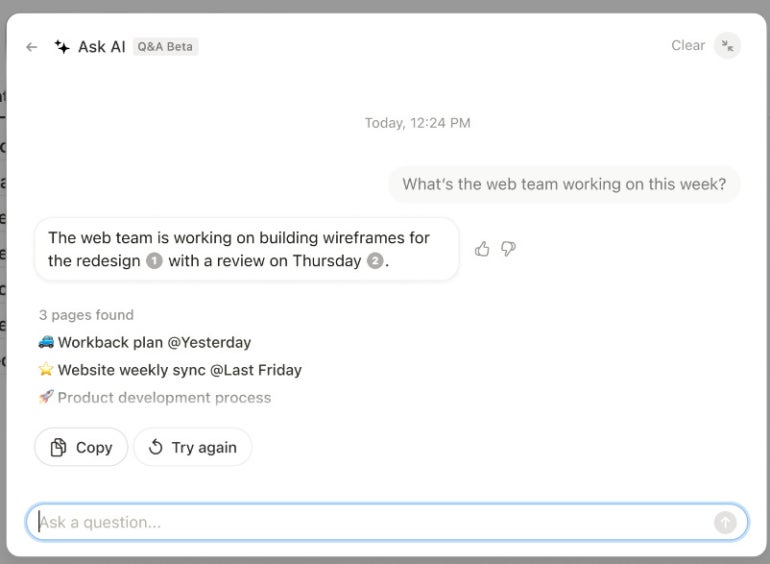

One of the best choices for startups and small teams that work with freelancers is Notion. The application is simple and fast to learn while still being affordable. You can explore the free version with 10 guests, or dive into their paid plans offering 100 to 250 guest user spots. Larger teams can also take advantage of the automation and analytics in higher tiers and all paid tiers can add on the Notion AI for document writing.
Pricing
- Free: Up to 2 users, 10 guests and unlimited pages for individual users.
- Plus: $8 per user per month, billed annually, or $10 per user billed monthly.
- Business: $15 per user per month, billed annually, or $18 per user billed monthly.
- Enterprise: Offering more support and advanced user controls, see sales to demo.
Features
- Work views like kanban, table and calendar.
- Private and closed teamspaces.
- Database syncing and basic automation in all tiers.
- Offers fast document creation as well as an AI add-on for paid plans.
- Automation for sprints, databases and syncing with Slack and GitHub.
Pros
- Ability to invite up to 100 guests to collaborate on a budget in the Plus plan.
- Public API to connect to your preferred software integrations.
- Affordable for startups and growing teams.
Cons
- Admin and security are mostly limited to Business and Enterprise tiers.
- Integrations require some manual setup.
- Can get costly in the Business and Enterprise plans for teams that need up to 250 guests.
Why we chose Notion
One of the best cloud solutions for remote team collaboration is Notion. While other tools may have more advanced capabilities, Notion offers a simple interface with features designed for content management and freelance projects.
For more information, read our Notion review.
Hive: Best for personalization
Figure H
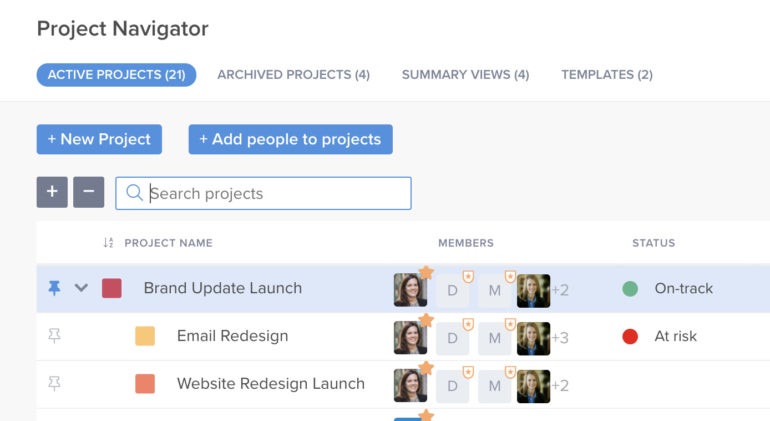

Virtual teams that want core project management features with flexible add-ons can personalize their experience with Hive. Add-ons you can choose from include security, proofing, external users, analytics and automation. The application comes with AI, reporting, basic automation, multiple work views and messaging.
Pricing
- Free: 10 users with unlimited tasks and collaboration.
- Starter: $5 per user per month, billed annually, or $7 per user billed monthly.
- Teams: $12 per user per month, billed annually, or $18 per user billed monthly.
- Enterprise: For more personalization, support, security and access to all add-ons, see sales for pricing.
Features
- Work views including kanban, table, calendar, table and Gantt.
- Multiple add-ons for features users can pick and choose.
- In-app messaging, note-taking and commenting for collaboration.
- AI assistant for writing and workflows.
Pros
- AI assistant available to use in all plan tiers.
- A plan calculator is available for figuring out tiers with add-ons.
- 24/7 in-app support in all plans.
Cons
- Add-ons are only for the Teams and Enterprise tiers.
- Reporting, project resourcing and customization are limited across tiers.
Why we chose Hive
Hive is a great choice for virtual teams that want more choice when it comes to individual project management features. The pricing is average and affordable for lower tiers with basic project management features, but it has options for bigger teams with more complex project needs.
For more information, read our Hive review.
What are key features of cloud project management software?
When choosing a cloud-based project management software solution, it’s essential to consider the features and capabilities that will best serve your team and organization. Here are five key features to look for in cloud project management software and why they matter.
Time tracking
Efficient time tracking is crucial for project management. It helps managers monitor team performance and allocate resources more effectively. Most cloud-based project management software includes built-in time-tracking tools to help businesses stay on top of deadlines and budgets.
Task and resource management
Effective task and resource management is crucial for successful project management. Cloud-based project management software should allow users to easily create, assign and track tasks, as well as allocate resources and monitor progress. This ensures projects stay on schedule and helps teams quickly identify any potential bottlenecks or areas that require additional attention.
SEE: Check out our list of the best task management software.
Gantt charts and kanban boards
Gantt charts provide a visual representation of project schedules, tasks and deadlines. They are an essential feature of project management software, helping teams stay organized and monitor their progress.
Kanban boards offer another visual way to manage tasks, projects and workflows. They help improve collaboration, identify bottlenecks and streamline processes. Most of the cloud-based project management software tools listed in this article offer both Gantt chart and Kanban capabilities.
Real-time collaboration and communication tools
Real-time collaboration and communication features are vital for remote teams. Cloud-based project management software typically includes features like file sharing, task commenting and instant messaging to keep teams connected and in sync.
Integrations with other tools
The ability to integrate with other tools and platforms is essential for seamless project management. Cloud-based project management software should offer integrations with popular tools like Slack, Google Drive, Microsoft Office and more, allowing users to streamline their workflows and easily share information between platforms.
What are the main benefits of cloud project management tools?
Cloud-based project management tools offer a range of benefits that make them an attractive investment for businesses. These benefits include:
- Accessibility: Cloud-based project management tools can be accessed from anywhere, at any time, as long as there is an internet connection. This makes it easy for remote teams and traveling employees to stay connected and up-to-date on project progress.
- Scalability: Cloud-based software is easily scalable, allowing businesses to add or remove users as needed, ensuring they only pay for the resources they require.
- Security: Cloud-based project management software providers typically offer robust security measures, including encryption and secure data storage, to protect your organization’s data.
- Cost savings: With cloud-based project management tools, businesses no longer need to invest in expensive hardware or infrastructure. Additionally, the cost of maintaining and updating the software is generally included in the subscription price.
- Improved collaboration: Real-time collaboration features ensure teams can work together effectively, regardless of location. These tools make it easy for users to provide updates, feedback and support in a unified digital workspace.
How to choose cloud-based project management software
Selecting the best cloud-based project management software depends on several factors, including your organization’s needs, team size, budget and preferred features. When making your decision, consider the following steps:
- Identify your requirements: Determine your team’s specific needs, such as task management, time tracking, file sharing and collaboration tools. Consider the solutions that deliver the features and capabilities that satisfy these needs.
- Evaluate integrations: Ensure the software can seamlessly integrate with your existing tools, such as CRM systems, communication platforms and file storage services.
- Consider scalability: Choose a solution that can grow with your organization, allowing for additional users, projects and features as needed.
- Assess user-friendliness: Opt for software that is easy to use, with intuitive interfaces and minimal learning curves for new users.
- Compare pricing and plans: Review different pricing options and plans to find one that fits your budget and requirements.
- Read reviews and testimonials: Learn from the experiences of other users to gain insights into each software solution’s strengths and weaknesses.
- Sign up for free trials and plans: Consider free trials of prospective cloud-based project management software to give you a taste of their premium features. Where free trials are not available, try out free plans for a first-hand assessment of the tool’s usability.
Review methodology
To identify the best cloud-based project management software options for 2023, we conducted extensive research and analysis of current market offerings. This process included evaluating factors such as customer reviews, project management-specific features, scalability, integration capabilities and usability; we also worked to get hands-on experience with most of the tools reviewed. Furthermore, we analyzed pricing information to ensure the chosen software solutions provide value to businesses of all sizes.
Looking for project management options that cater to your specific business size? Check out these top project management tools for enterprise teams and small businesses.

